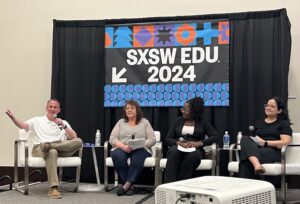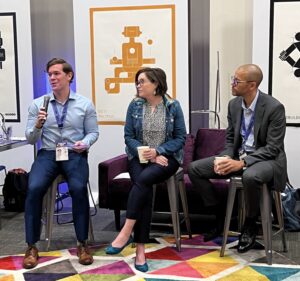The Luminary Labs team’s insights from SXSW EDU 2024.
SXSW EDU has long been a highlight on Luminary Labs’ conference calendar, and this year was no exception. Our team attended the annual event in Austin, Texas, to connect with leaders working on new learning models, education delivery methods of the future, AI, and education R&D.

Engagement Manager Natalia Allen (right) led a panel on “Space Skills for Careers on Earth” with Rob LaSalvia from NASA, Lisa Martino from the University of Central Florida, and Quincy Brown from the National Space Council.
This year, we led a panel discussion on “Space Skills for Careers on Earth” — with speakers from NASA, the National Space Council, and the University of Central Florida — to highlight our work on behalf of the U.S. Department of Education’s Middle Grades CTE Accelerator. We also hosted a breakfast chat in Siegel Family Endowment’s Futures Studio to share the newly launched Learning Landscapes Challenge with education leaders and influencers. Both of these programs exemplify a major undercurrent at SXSW EDU: the desire for partnerships that connect education, industry, government, and philanthropy in new and productive ways.

Engagement Manager Logan Cummings (left) hosted a breakfast chat about the Learning Landscapes Challenge with Jamie Jutila from the Walton Family Foundation and Joshua Elder from Siegel Family Endowment.
Discussions around diversity, equity, and inclusion (DEI) — another major undercurrent in Austin — have been at the forefront in recent years. Both corporate and higher-education DEI initiatives are facing an uncertain future, but equity in schools remains a clear priority for educational leaders at this conference. SXSW EDU programming reflects an evolving view of the topic: In past years, sessions focused specifically on equity, but this year, panelists across topics rooted their approaches and discussions in creating more equitable experiences and outcomes.
Of course, some themes were more overt. We’re back from Austin with fresh insights, and we’ve curated top takeaways on student agency, outcomes measurement, and emerging AI trends.
Moving beyond student centricity to enable student agency
The importance of centering the needs, preferences, and perspectives of students in educational design is hardly a new topic. The descriptor “student-centered” seems ubiquitous in education programs. However, across panels discussing diverse topics such as work-based learning, designing schools for well-being, and data-driven personalized learning, we noticed a commitment to deepening how students are engaged and consulted in educational design. Several panels highlighted concrete opportunities to push beyond student-centricity toward student agency.
In “Future-Ready Schools: Design for Well-Being and Resilience,” panelists from Fielding International and the Sun Prairie Area School District discussed how students played an active and agentic role in the redesign of their schools. In a recent example, more than 100 students were not only consulted, but were deeply involved in the design process, conducting site visits to innovative high schools, identifying design principles, and voting on formal decisions. Similarly, in “Why the Future of Work Needs a Work-Based Learning Movement,” speakers focused on finding opportunities to authentically engage students in solving real business problems. Too often, businesses treat work-based learning as purely a learning opportunity for students and overlook the value that they can bring. Employers have an opportunity to identify real business challenges that would benefit from students’ unique perspectives, increasing the value of these experiences for businesses as well as learners.
The same theme popped up in “Creating a Data-Driven, Personalized Education System” — but this panel raised the bar by bringing a student advocate onto the stage. Arivumani Srivastana, a recent graduate and board member of the Kentucky Student Voice Team, highlighted the importance of not just giving students ownership over their educational data, but actively involving them in every step of designing the data architecture — including data collection, reporting, and credentialing systems. Hearing directly from students is especially insightful and inspiring; next year, we hope to see even more student voices actively guiding conversations. As the Learning Economy Foundation’s Chris Purifoy pointed out, it’s important to make sure data — and education, more broadly — work for everyone: “Self-sovereignty is an important equity moment.”
R&D as a tool for understanding and improving outcomes
The COVID-19 pandemic highlighted that learning loss encompasses much more than just academic setbacks — and that standard approaches can’t always accurately evaluate student success. Traditional metrics, like test scores, fall short of capturing the full spectrum of learning and development. Across panels covering topics such as competency-based education and community learning ecosystems, a common theme emerged: Non-academic benefits, such as 21st-century skills and social capital development, significantly influence students’ long-term success. But how do we effectively measure these non-traditional outcomes?
Answering that question will require investing in research and development (R&D) to codify such outcomes. In “Building Networks for Success: The Social Capital Advantage,” panelists from Clayton Christensen Institute and BUILD spoke to the importance of carefully researching the potential of social capital and the risks of increased inequity as they relate to student-centered programs and innovations. The evolution of student success metrics will help drive toward a more equitable education system, helping students succeed in the 21st century and attracting investment from outcomes-centered funders.
In several panels focused on R&D for future educational models and interventions, speakers kept returning to the importance of equitable design. In “How Federal Partnerships Are Transforming Ed R&D,” Dr. James L. Moore III noted that R&D efforts need to meet students where they are instead of expecting students to adapt to institutions. In the same session, Aparna Ramanathan underscored the importance of “moving the needle on the biggest problems for the most vulnerable learners.” In “Why Education Needs More Big Bets,” the U.S. Department of Education’s Roberto Rodríguez said that if our aspiration is to close the opportunity and achievement gaps, we must build the R&D infrastructure to get there.
Beyond official conference programming, the Alliance for Learning Innovation (ALI) Coalition’s cocktail hour showcased the power of assembling the right mix of stakeholders to catalyze change, particularly in the realm of research and development. This gathering, featuring key leaders from the U.S. Department of Education, The Education Trust, and AmeriCorps, underscored the appetite for partnership and potential for change. The room buzzed with possibilities: The time to invest in research and development is now. When focused on creating more inclusive and diverse measures of success, our concerted efforts have the power to establish new benchmarks for funders and policymakers alike. R&D can drive education forward.
AI education that puts humans first
At last year’s conference, educators and students were just starting to experiment with ChatGPT, and conversations oscillated between fear and hope for the potential of generative AI in the classroom and beyond. Now, AI tools are part of every industry, including education. Technology will continue to evolve and new tools will emerge; with that in mind, how should we prepare students for the world?
Panelists at “EdTech vs. TechEd: Making Emerging Technology Accessible,” recommended against focusing instruction solely on specific skills related to specific technology tools, but rather developing process-based skills so students can tackle challenges that will emerge alongside new technologies. CSforAll’s Dr. Leigh Ann DeLyser emphasized the need to “prepare the solvers” — it is impossible to predict where AI technology will go, but education can help students develop problem-solving abilities. To do this, education policy will need to keep up with the rapid pace of technological change. Albert Palacios, Director For Cyber Education in the White House Office Of The National Cyber Director, emphasized the need to teach problem-solving skills and embed interactions with new technologies throughout a students’ educational journey.
To be sure, equity is also a consideration in both the development for and use of AI in the classroom, and conference sessions raised questions of whether the increasing prevalence of AI will widen or close existing gaps. In “Equity Concerns in AI & Education,” panelists discussed emerging trends in AI. Adam Goldfarb, a program officer at the Bill and Melinda Gates Foundation, shared that “one-third of teachers have used AI in their work, one-fifth use it regularly, and 75% of those who use AI say they plan to use it more next year; 28% of those who don’t use AI expect to use it next year.” However, gaps are already emerging: Schools in communities experiencing poverty, driven by concerns around the cost of implementation, are far less likely to use the technology. Additionally, inequities may be built into the technology itself — MIT researcher Sarah Schwettmann explained the potential for bias in the data used to train the tools, and emphasized the importance of making sure that these biases are evaluated and addressed before new AI tools are widely used.
Questions about education, technology, and equity are not only important in K-12 education; these conversations are also central to making progress in the adult education space. In “ALL IN: Activating Human Potential via Multiple Literacies,” Priyanka Sharma spoke to the equity-centered approach of World Ed on topics such as the digital divide, where wraparound support recognizes that “the answer is not technology, the answer is human beings.”





